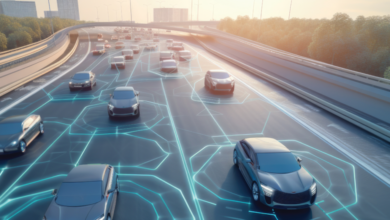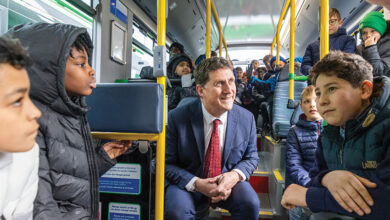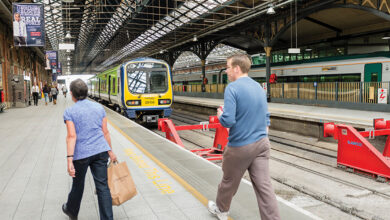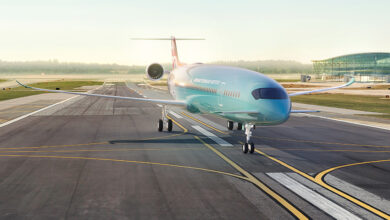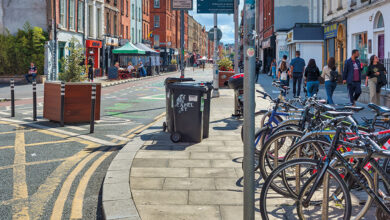The future of connectivity and mobility post-Covid

eolas invited four senior players within the Irish transport sector to discuss the impact of the Covid-19 pandemic on their respective organisations and the future and recovery ahead for the sector.
“Like all industries, it’s been a tough year for us,” Jim Meade, Chief Executive of Iarnród Éireann says. “Like all public services, we continued delivering services for essential workers, students etc. We had to pivot quickly to ensure the safety of both staff and customers. While the majority of our 4,100 staff are frontline, we did manage to get about 18 per cent to work remotely during that time, within two weeks we had them offsite, and they remain offsite.”
While all participants in the discussion are keen to express admiration for the work undertaken by their staffs throughout such a challenging period, a recurring topic is how the pandemic has affected passenger numbers across the various types of transport in Ireland.
“It has been an absolute disaster; our sector has been ravaged,” says Dalton Philips, Chief Executive of daa, which manages both Dublin and Cork airports. “In terms of passenger numbers, we are down 90 per cent on pre-Covid figures. If you take Dublin Airport today, traditionally at this time of year you would have 100,000-115,000 passengers per day going through the airport, we’re down to around 10,000 per day. In terms of the financial situation, we lost nearly €300 million last year, and we avail of government supports in terms of wage subsidy schemes but we have to carry our own water in terms of everything else.”
Ciarán Rogan, Director of Commercial and Business Development with Dublin Bus, experienced similar capacity issues but says that the agility lessons within the quick adjustment were worthwhile: “From the very outset, business dropped 90 per cent in terms of passenger numbers. We’re sitting at roughly 50 per cent at the moment so there has been some recovery but the toll that has taken economically has been huge. I would echo that we had support from the NTA and the Department. As an organisation, we have learned to become very agile very quickly. We had to make changes with the way we worked and how we communicate to passengers because of the changes to our capacity and we had to do that very quickly.”
Conor O’Dowd, CEO of the Port of Galway, says that the port did not suffer the same extent of damage due to its role in the maintenance of Ireland’s supply chain. He does, however, note that the port’s carparking business was affected: “One interesting thing was that we have a very significant parking business, and you would not get a better economic activity barometer than our car park machines. In the case of a new lockdown or the easing of restrictions, you would certainly notice that in your take.”
As things begin to turn towards recovery from the economic damage wrought by the pandemic, the transport sector knows that it must be patient with regard to returning to pre-Covid passenger numbers. 2024 appears to be the agreed-upon target year for numbers to return to 100 per cent of 2019 levels.
“Looking at case studies from around the world at places that have experienced Covid in advance of us or come out the other end quicker, cities in China and New Zealand, the message is that things still haven’t come back to pre-Covid levels of passenger numbers,” Rogan says. “90 per cent is considered to be a result. A big thing is figuring out at what stage employment patterns return to normal, as I go through Dublin, I still see large office blocks completely empty. Even if people are working from home one day per week, that’s still a 20 per cent reduction in terms of commuting numbers.”
“A big thing is figuring out at what stage employment patterns return to normal, as I go through Dublin, I still see large office blocks completely empty. Even if people are working from home one day per week, that’s still a 20 per cent reduction in terms of commuting numbers.”
— Ciarán Rogan, Director of Commercial and Business Development, Dublin Bus
Philips says that airport projections show the potential for even lower passenger numbers in 2021 when compared with 2020. While pent-up demand for visiting friends and relatives and taking holidays will surely explode when possible, Philips does see drawbacks in the form of a reduction in business travel: “The business model has changed, and I think you’re going to see a lot of people travelling initially for business because they haven’t been able to for a year and a half, but I think longer-term you’re talking about a 25 per cent or 30 per cent reduction in business travel because people will be using technology instead.”
For Meade and Iarnród Éireann, who have also suffered falls in passenger numbers, there is opportunity in less busy trains and tracks. “We look at it slightly different as railway custodians, because we have, for probably the first time we have the opportunity to build capacity of our network ahead of demand, we’re normally trying to catch up,” he says. “We’re about to approve a framework for 750 new vehicles which will be either electric or battery electric. Projects have continued during Covid, we’ve been doing the work behind the scenes and now they have been approved by our board and are going through the government processes. That’s the next step for us, creating the capacity so people can get back to transport.”
In both the situation as it exists and the renewable agenda that has become so important, O’Dowd also sees an opportunity for the Port of Galway, which is developing a “new port facility that will enable the development of 17 acres of prime inner-city lands”. “There’s a once-in-a-generation opportunity for Irish ports and the Irish economy to use ports in an offensive capacity to cater for the renewable energy opportunity. We’re seeing the build out on the east coast but as time evolves, we will see the building of capacity off the south and west coasts. It’s so important for a company such as ours to learn from industry leaders, where ports are being redeveloped in to cater for the deliverance of offshore wind in places like Norway and Denmark.”
The green agenda and Brexit were the two externalities defining the market that each of the participants work in before Covid, and they will once again play defining roles as transport looks to recover. “We have the cross-border service with Belfast, and we had to ensure that the changes we were experiencing were seamless from a customer’s perspective,” Meade says, before turning to climate. “The DART+ programme is going to triple the electrified area of the Greater Dublin Area and double the capacity. What that means from a passenger perspective is that 80 per cent of passenger journeys will be green at the point of consumption.”
Philips states that Brexit is “absolutely a negative” for daa, with one-third of its business being done with UK business. In the case of sustainability, daa has decreased its emissions by 50 per cent, but will need to reduce by a further 50 per cent by 2030, a task that requires help from regulators, Philips says: “In our case, we don’t set our charges that we levy on airlines to come in and out of Dublin Airport, that’s set by the regulator, who needs to be attuned to the sustainability challenge because in the longer-term, it can pay for itself but in the shorter-term, there’s a huge cost involved in updating legacy buildings, putting new infrastructure that supports a cleaner environment in. If we’ve got a regulator that doesn’t take that into account and airlines that are only interested in the short-term, we won’t be able to invest in sustainable infrastructure.”
Concluding, Rogan sounds a positive note and something of a call to action for the sector as transport prepares to take on the three-headed dog of Brexit, Covid and climate change: “More people are going to have to move from the car to mass transit so that’s bound to increase passenger numbers on trains and buses. That’s completely consistent with BusConnects, which envisages a 23 per cent increase in passenger numbers within Greater Dublin in the next four years. Sustainability will drive big wins for public transport and the time is now to make the improvements, put the investments in, improve the infrastructure and increase the capacity.”

